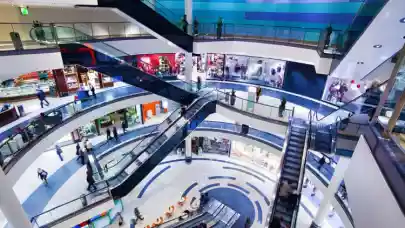
The increasing number of vaccinations is allowing the retail sector to catch its breath, with customers returning to ‘brick-and-mortar’ stores. JLL forecasts that total new supply could hit 540,0000 sqm in 2021, marking a return to pre-pandemic performances.
Although the Polish retail market is still struggling with implications caused by COVID-19, forecasts look favourable compared to the rest of Europe. According to Oxford Economics, retail sales in Poland are expected to grow by 4.9% annually until 2023, placing the country among the top European countries.
Figures from The Polish Council of Shopping Centres (the PRCH) show a rapid return of customers to ‘brick-and-mortar’ shopping after a period of restrictions related to the recent lockdown. Footfall in the first week of the reopening of shopping centres was 97% of the result registered in 2019, before settling down at 87% by the end of May. Turnover in shopping centres in May came in at 96% of 2019 results, indicating a high conversion rate.
"The visitation results are reasons to be cautiously optimistic. It is noticeable that consumers are hungry for the opportunity to actually go out shopping and want to make up for those lost lockdown months. This phenomenon could be described as ‘revenge shopping’", comments Anna Wysocka, Head of Retail Agency, JLL.
Retail supply – possible return to pre-pandemic performances
Compared to the same period in 2020, H1 2021 was characterised by increased construction activity.
"In the first half of 2021, developers completed 242,000 sqm of GLA across all formats, with a further 447,000 sqm under construction. Our analysis suggests that by the end of 2021, new supply could total around 540,000 sqm. This is roughly on a par with pre-pandemic 2019. 40% of the new completions will be retail parks", explains Joanna Tomczyk, Senior Research Analyst, JLL.
The trend towards locality and quick shopping continues. Retail parks and convenience centres accounted for 43% of the supply delivered in the first half of 2021. As a result of the reshuffling of hypermarket operators, 47% of new retail space was delivered within stand-alone retail warehouses. The remaining 10% of the new stock was delivered in the form of shopping centres. In Q2 2021, this year’s first new shopping centres were opened: Galeria Sekunda in Jędrzejów (13,000 sqm of GLA) and Galeria Odyseja in Brzesko (9,300 sqm of GLA).
"There is a growing segment of mixed-use projects that provide additional retail units to the market. Mixing different functions but also modern design elements with historic architecture translates into place-making projects and new urban spaces. An example is Browary Warszawskie, developed by Echo Investment, which integrates office, residential and retail functions within the historical heritage of the location", comments Joanna Tomczyk.
Demand – strong debuts and new strategies
The new reality of the market, as well as the retailers' experience during the pandemic, has influenced expansion strategies, especially with regard to the launch of shops in alternative locations.
"Although tenants are looking for new formats and to diversify their locations, they have not given up on developing their operations in shopping centres. The Irish fashion giant Primark has announced another two upcoming locations in major shopping centres in Kraków and Katowice. Rituals Cosmetics, with its debut set for August 2021 in Westfield Arkadia in Warsaw, plans a chain of 100 stores by 2027 in Poland. Similarly, Polish off-price chain HalfPrice (owned by CCC) opened seventeen locations within two months of its debut, in locations ranging from prime shopping centres to high street premises", comments Joanna Tomczyk.
Three new brands made their Polish debut in Warsaw in the first half of the year. LEGO opened its first own store in Westfield Arkadia, while Italian menswear firm Camissima and Yargici fashion brand from Turkey started operating in Galeria Mokotów.
Omnichannel sales and sustainability
Before the pandemic, the share of e-commerce in Poland’s retail sales was 5.6% and varied depending on restrictions placed on the operations of retail facilities. Retail forecasts for Poland show a retail sales growth of 3.3% annually until 2025, of which 90% of purchases will still be made in ‘brick-and-mortar’ stores.
"To see how e-commerce is shaping up, we need to wait for the market to stabilise. Regardless, tenants and landlords are aware of the necessity to build a multi-channel sales model or a presence on sales platforms such as Zalando or Amazon, and are looking for systems to integrate their facilities with online options", says Anna Wysocka.
Although only 15% of retail buildings are currently environmentally certified (according to the Polish Green Building Council), the retail sector is demonstrating a commitment to sustainability. Both tenants and landlords are implementing innovations to protect the environment.
"For example, the Carrefour chain uses low groundwater temperatures to lower the air temperature in some of its facilities and uses CO2 as a refrigerant. Silesia City Center has installed photovoltaic panels on its roof, reducing carbon dioxide emissions by as much as what one hectare of pine forest can absorb in a year. LED lighting and charging stations for electric cars are gradually becoming standard in shopping centres. In addition, planned development processes more and more often include the delivery of sustainable facilities", Anna Wysocka points out.
Global fashion giants such as H&M, United Colors of Benetton, Esprit and Tommy Hilfiger, sell clothing collections made from recycled products and biodegradable natural materials. LEGO is testing blocks made of recycled plastic, and second-hand clothing firms are expanding both in ’brick-and-mortar’ and ecommerce arenas (for example Zalando Pre-Owned, where second-hand goods are sold).
Retail investment market - many transactions but of lower values
"The pandemic and related activity restrictions impacted the retail market performance in the first half of 2021. The total retail investment turnover stood at approximately EUR 290 million, the lowest value for an H1 since 2013. However, the number of transactions was among the highest ever recorded, and the low turnover was due to the type of assets that are currently most popular with investors. These are smaller and more dispersed assets. Retail parks, convenience centres, grocery shops and DIY stores continue to be the main focus for investors. Recently, however, we have also noticed increased activity in opportunistic transactions involving shopping centres", comments Adam Kiernicki, Senior Director, Retail Investment, JLL.
The attractiveness of large shopping centres is directly dependent on the prospects of the pandemic ending and the chances of further restrictions receding.
"Turnover recorded after shopping centres reopened in May has clearly bolstered investor sentiment", adds Adam Kiernicki.
Despite the lack of transactional evidence for H1 2021, the prime yields for shopping centres are estimated at 5.25%. So far, prime cap rates for the best retail parks remain stable at around 6.80%. However, the high level of interest and limited availability of a good product may result in compression in the short term.



